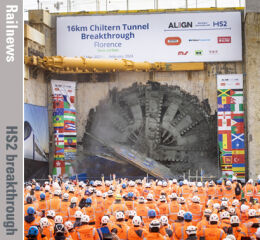Posted 28th February 2024 | 1 Comment
HS2 milestone as tunnelling machine breaks through in the Chilterns

A tunnelling machine on HS2 has completed a 16km journey by breaking through at the North Portal of the Chiltern Tunnel.
The journey of TBM Florence has taken 2 years and 11 months, travelling at about 16 metres a day, but a train will travel through the tunnel in a few minutes when HS2 is open between London and Birmingham.
Florence, which weighs in at 2,000 tonnes, has excavated 3 million cubic metres of material during the journey, which will be used to restore a grassland. Florence is one of 10 machines excavating 51km of tunnels, and was the first to be launched, in May 2021.
Two identical TBMs were used to create the twin-bore Chiltern Tunnel, which stretches from the South Portal near the M25 to South Heath in Buckinghamshire. A second TBM, named ‘Cecilia’, is almost at the end of its trip in the parallel tunnel, and is due to break through in the coming weeks.
Rail minister Huw Merriman said: ‘This ground-breaking moment for HS2 demonstrates significant progress on the country’s largest infrastructure project, with “Florence” paving the way for faster, greener journeys between London and Birmingham while supporting hundreds of jobs and apprenticeships along the way.
‘Today’s breakthrough of HS2’s longest tunnel highlights the momentum behind the project and the achievement is testament to the hard work and dedication of the 450-strong team helping deliver the line that will transform rail travel for generations to come.’
Each TBM is an underground factory designed specifically for the geology of the Chilterns. Having bored another few metres each day, the TBM then lined the new section with precast concrete segments.
Four similar TBMs are being used for the London approach tunnels, while another two will work on Birmingham’s Bromford Tunnel. Preparations are also underway for the launch of two more machines to excavate the Euston tunnels, although the fate of the terminus at Euston is still undecided and the first London terminus for HS2 will almost certainly be Old Oak Common.
The breakthrough came a week after HS2 had published new research claiming that high speed rail will boost the West Midlands economy by £10 billion during the next 10 years.
HS2 Ltd executive chairman Sir Jon Thompson said: ‘Today is an incredible day of HS2 and I’d like to thank the hundreds of people who’ve worked so hard over many years to make it happen. Once complete, HS2 will dramatically improve journeys between our two largest cities and also free up space on the existing main line for more local trains.
‘We’ve still got a lot of work to do, but historic moments like today really underline the huge amount of progress that’s been made and the fantastic engineering skills we have on the project.’
Reader Comments:
Views expressed in submitted comments are that of the author, and not necessarily shared by Railnews.

david C smith, Bletchley
Is this an example of "Overkill" specification pushing the whole project beyond viability ? How much extra costs are incurred through the tunneling involved in speeds of 400 km/h ? At 300 km/h, maximum , for example, only around 6 to 10 minutes would be likely to be added to the London to Birmingham schedule compared to a 400 km/h maximum*. Then what about the capacity relief involved? Yes, indeed , but if only that had been the main consideration, why go for the hyper-expensive option that is actually being built?
[*The maximum speed is not 400km/h any more but 360km/h.--Ed.]